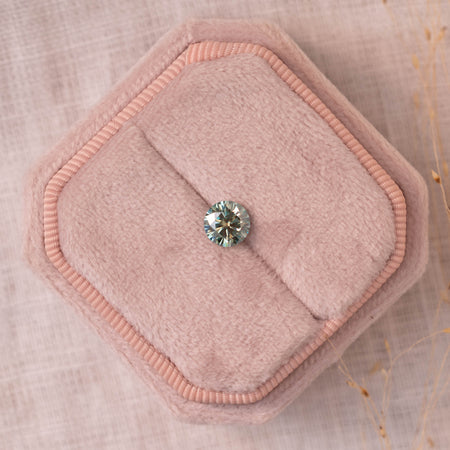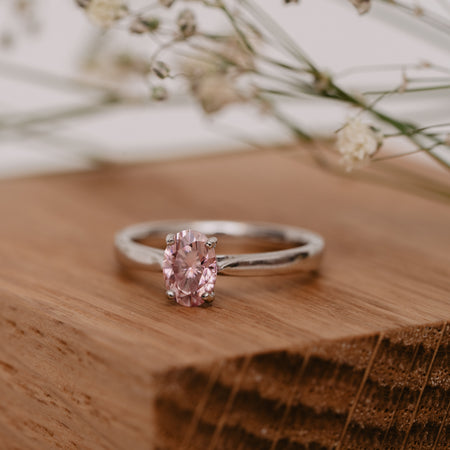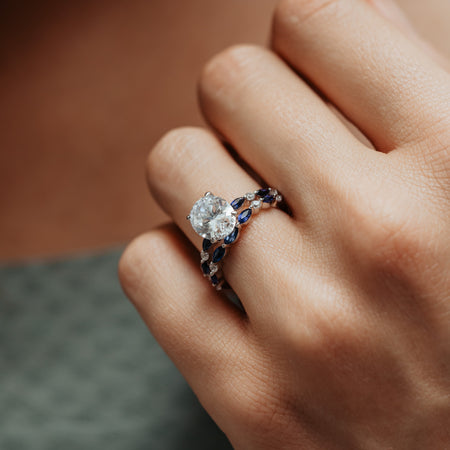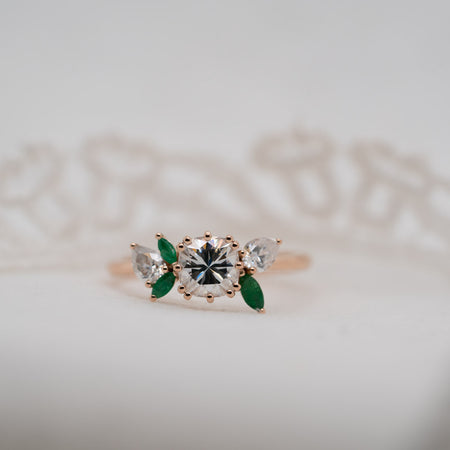
Sparkle In Full Colour
Ethica’s selection of lab grown gemstones (also called lab created gemstones or synthetic gemstones) are the best on the market.
They are created using the most scientifically advanced processes to produce beautiful, precision-cut gemstones in a wide variety of colours, sizes and shapes.
Personalising your jewellery with an ethical coloured gemstone has never been easier!
What Are Lab-Grown Coloured Gemstones?
Lab-grown gemstones are a stunning, ethical and affordable alternative to earth-mined gems. By recreating the earth’s natural process in a controlled lab environment, we are able to create Rubies, Emeralds and Sapphires that are higher quality and more beautiful than most earth-mined equivalents. With a lab gemstone gemstone, you get a show stopping centerstone without having to worry about negatively affecting the environment or humanity.

Chathams Stones
Chatham is the worlds leader in laboratory grown gemstones and diamonds. All chatham gems contain the same physical, chemical and optical properties as their mined counterparts. The only difference is where they are from, above ground vs below.
We're proud to supply a range of Chathams stones, including Sapphire, Alexanderite, Ruby, Spinel and Chrysoberyl.

Coloured Moissanite
The Ethica Diamond collection has now extended into a range of beautiful coloured gemstones that are specifically grown individually to the intrinsic colour of them, meaning they are not post-treated and will never fade. They are also extremely durable, unlike their natural counterparts, which can be prone to cracking and chipping. How prone a gemstone is to external forces, such as breaking and chipping, is measured scientifically on a scale of hardness called the Mohs. Diamond being the hardest, which is measured at 10. Natural emeralds for example are 7.5, Topaz is 8 whereas Sapphire and Ruby is at 9 Mohs. Our moissanite coloured gemstones are almost as durable as diamond at 9.7 Mohs. The other good news is that each gemstone is independently graded by the GRI - Global Gemological Research Institute and comes with full certification of authenticity.

Lab-Grown Precious Gemstones
Synthetic gemstones are laboratory-grown versions of natural gemstones, with the same chemical composition and physical properties as their natural counterparts. They are created using various techniques, such as hydrothermal growth or flux melting.
Because they are grown in controlled environments using advanced technology, which require no mining, their origins are therefore traceable and responsible, have a smaller carbon footprint and result in less environmental impact.
These gemstones mimic their natural counterparts, therefore they also have the same levels to scratch resistance that requires careful wearing and special care.

Fancy Lab-Grown Diamonds
A fancy coloured diamond refers to a diamond that exhibits a distinct, attractive colour other than the traditional white or colourless varieties. They are available in an array of colours, tones and saturations – some are certainly more rare than others, but overall coloured diamonds are far more rare than their white counterparts. Colours can include shades of yellow, orange, green, blue, pink, red, and even more exotic hues like purple or violet.
The more intense and vibrant the colour, the more rare and valuable the diamond tends to be. Additionally, larger-sized coloured diamonds are even rarer than smaller ones, further increasing their value.
It is ideal to view a video of a coloured diamond before you choose as a more intuitive response is needed rather than relying a technical diamond grading report.
This is because colours and their saturation can vary so greatly.
While round diamonds are a classic and traditional choice for engagement rings, this shape does not lend itself best to coloured diamonds as they don’t display the colour tones as well as a radiant or cushion cut diamond, for example.
While coloured diamonds carry a price premium, they can add a unique and stunning feature to your design.
What's the Difference Between Synthetic, Simulated and Created Gemstones?
Synthetic gemstones
Some people make distinctions between different kinds of synthetic or lab-grown gems. It's important to note that the terms used to describe these different types of gemstones can vary, so it's always best to clarify the specific characteristics and origins of a gemstone when purchasing or discussing it.
You'll hear many terms used interchangeably with synthetic, such as "artificial," "lab-grown," "lab-made," "man-made," etc. All these terms identify gemstones created in laboratories, not in nature.
There are many processes for synthesising gems. Some are inexpensive, some are very expensive, but they're all conducted artificially, in a lab. They may mimic or reproduce natural processes and use the same ingredients found in the natural stones. However, these processes occur in labs, not underground in nature.
Some synthetic stones are chemically and optically identical to their natural counterparts. For example, synthetic emeralds may be real emeralds but not natural emeralds.
Depending on the process used, synthetic gemstones may even have the same inclusions and flaws found in natural gems. Or, they may have telltale signs they're synthetic. Distinguishing between synthetics and their natural counterparts can be very difficult.
However, some synthetic stones just look like natural stones without being chemically and optically identical to them. (Some synthetic stones have no counterparts at all in nature). Gemstones synthesised in a lab that simply imitate natural stones are called simulated gemstones or simulants.
Simulated gemstones
Synthetic gemstones are made in a laboratory using the same chemical composition and crystal structure as natural gemstones. They are essentially identical to natural gemstones but are created in a controlled environment.
Some examples of synthetic gemstones include synthetic CVD or HPHT diamond, synthetic ruby, and synthetic spinel. Synthetic gemstones are often preferred due to their affordability, ethical sourcing, and quality. They can be difficult to distinguish from natural gemstones without specialised equipment or expert knowledge.
Created gemstones
A coloured gemstone is considered a simulant when it is artificially created or modified to imitate the appearance of a specific natural gemstone, but its chemical composition, physical properties, and origin differ from that of the natural gemstone it is imitating and not all simulants originate in labs.
They are usually made from materials such as glass or plastic and it is important to note that these imitations are not considered genuine gemstones and are often of lower value than their natural or synthetic counterparts. Although glass can be artificially coloured and shaped to resemble various gemstones such as amethyst, ruby, and sapphire. However, it differs in chemical composition and physical properties from natural and synthetic gemstones.
Regardless of its origins, a simulated gemstone is a piece presented to "look like '' another gemstone. A close gemological analysis would reveal its true identity. Simulants are also called imitations, faux, and fakes. Some retailers may be honest about selling simulants. Others may not disclose what the gem truly is. (Sometimes, gems are sold with misleading names).
In summary, a simulant is an artificial gemstone that imitates the appearance of a natural gemstone, while a synthetic gemstone is chemically and physically identical to its natural counterpart but is created in a lab.
Treated natural gemstones
There are many gemstone treatments and enhancements used to improve natural gemstone rough and you can assume that most are heat treated unless otherwise specified. For example, heat treatment on sapphire improves colour and melt silk inclusions. Some people would consider all treated stones as synthetic or created gemstones. However, this is a grey area, because if a natural gem receives extreme treatments, should it not fall under the synthetic category?
Hydrothermal vs flux fusion
We also think consumers should know the difference between inexpensive flame fusion/hydrothermal or pulled created gemstones and the more expensive lab-grown gemstones.
Ethica offers the most technologically advanced lab-grown gemstones created using a single growing method called Flux Fusion. During the growing period (six months to a year) the chamber’s temperature and chemistry are carefully controlled to duplicate the environment in the area of the earth where that gemstone variety forms. This process results in the growth of perfect crystal faces and has a crystal shape most similar to natural gemstones. Since foreign materials found in the earth are eliminated from a starting ‘seed’, the crystal grows more predictably, which in turn consistently produces the best qualities and colours - even better than those found in nature. Once this process is finished, the outcome is a rough crystal identical to one found in nature which results in the highest quality lab grown gemstones available.
Hydrothermal synthetics on the other hand, don't have any of these inclusions, and these stones tend to be much thinner than natural material. They are grown under conditions very similar to the heat and pressure that natural gemstones form in, however, the main difference is they do not form freely-grown crystals, instead forming an elongated hexagon shape.
Not all gem varieties can be made inexpensively by flame fusion or pulling: sapphire, ruby, and spinel are the main ones. That’s how sapphire watch crystals are made.
In these inexpensive processes, powdered chemical ingredients are melted into a large block in an hour, not grown as crystals over a year. The crystal structure of flame fusion/hydrothermal or pulled synthetics is disoriented, like glass, due to the way it’s made. It doesn’t have natural crystal faces. From a crystallography perspective, flame fusion isn’t the same as mined ruby or sapphire.
The crystal structure of flux-grown ruby or sapphire is the same as mined ruby and sapphire. Its internal structure is identical. That’s why it’s worth devoting a year to letting it grow. Because the structure is identical, you get the same brilliance and reflection from the crystal structure and that is why people fall in love with gems in the first place.
In the end, that’s what this is all about: understanding what the differences are between different kinds of gems so you can make an informed smart choice: mined, lab-grown, man-made, or imitation. It’s up to you!
To summarise
In conclusion, synthetic gemstones are chemically and structurally identical to natural gemstones, simulated gemstones look like natural gemstones but are made from different materials and created gemstones are usually just synthetics marketed specifically as a gemstone. It is important to be aware of the difference between synthetic gemstones and simulated gemstones. Synthetic gemstones, such as synthetic diamonds or synthetic rubies, are created in a laboratory and have the same chemical composition, physical properties, and crystal structure as their natural counterparts. Simulated gemstones, on the other hand, are created or modified to imitate the appearance of natural gemstones but do not have the same chemical composition or physical properties. They are often made from materials like glass or coloured cubic zirconia. When purchasing gemstones, it's crucial to understand whether you are buying a natural stone, a synthetic stone, or a simulated stone, as this can greatly impact the value and rarity of the gemstone.
Fancy coloured diamonds
Famous fancy coloured diamonds
One of the most famous fancy coloured diamonds is the Hope Diamond – a 45.52-carat stone with a deep blue colour. It is one of the most sought-after gemstones in the world and official records can trace its ownership back almost four centuries. Other famous fancy diamonds include the Tiffany diamond – a 128.54-carat canary yellow diamond that was mined in 1877 in South Africa – and the Dresden Green, a 41-carat natural apple-green diamond that is believed to originate from India and first shows up in records in 1722. The most famous fancy red diamond is the Moussaieff Red, originally from Brazil and mined in the 1990s. In its rough, original form it measured 13.9 carats, although it has since been cut down to 5.11 carats.
Are coloured diamonds natural?
Yes, coloured diamonds are natural. They are formed through the same geological processes as white diamonds but with additional elements or structural irregularities that give them their unique colour. The presence of impurities or changes in the diamond's crystal lattice during formation can result in colours such as yellow, brown, blue, green, and pink. Natural coloured diamonds are quite rare and highly valued for their beauty and uniqueness. However, in addition to natural fancy coloured diamonds, there are also treated or enhanced fancy coloured diamonds on the market, as well as lab grown fancy coloured diamonds.
How is a fancy coloured diamond formed?
Fancy coloured diamonds contain impurities or structural defects within their chemical composition. These are caused by the conditions that were present during the crystallisation process when the diamond first formed. They are also the result of billions of years of exposure to heat, natural radiation, or the saturation of natural elements. Different impurities and conditions result in different hues, as well as different intensities of those hues.
You can find fancy-coloured diamonds in various shades, including pink, blue, and yellow. Naturally, only 1 in 10,000 diamonds present with a fancy colour, and most times, the colour isn't very saturated. This is because, in the Earth, impurities accidentally react with carbon, making coloured diamonds more or less an error in the process.
What is a fancy coloured lab grown diamond?
A fancy-coloured lab diamond undergoes the same technological process as a colourless lab diamond. The body of the diamond features a dazzling hue instead of a classic colourless appearance. Any diamond that is not the traditional white is considered a fancy diamond.
Fancy colours include hues like yellow, pink, blue, green, and various shades in between. These diamonds are created in a laboratory using processes such as chemical vapour deposition (CVD) or high-pressure high-temperature (HPHT) methods. Lab-grown diamonds are chemically, physically, and optically identical to natural diamonds, but they are created in a controlled environment rather than being formed naturally underground over millions of years. Fancy lab-grown diamonds therefore offer a sustainable and more affordable alternative to their natural counterparts.
How are fancy coloured lab grown diamond made?
The fancy colours in lab-grown diamonds are achieved by introducing specific elements or impurities during the growth process, replicating the conditions that create coloured diamonds in nature.
In a lab, impurities, which are substances other than carbon, are added in specific amounts under a controlled environment to achieve amazing colours.
Each colour is the result of a different compound.
Brown, orange, and yellow: nitrogen is mixed with carbon.
Blue: tiny amounts of boron with carbon.
Green: gamma radiation causes green diamonds.
Pink and Red: experts think higher pressure may change the structure of the diamond, resulting in pink and red.
In a lab, scientists can slightly alter the gas mixture with these compounds to change the colour of the diamond.
What are the most popular fancy colours of lab diamonds?
Yellow & Brown
Yellow and brown diamonds have held the title of most famous coloured diamonds for a while. Yellow diamonds are sometimes referred to as canary diamonds, while brown is known as chocolate diamonds. Fancy yellow diamonds, are the least rare fancy coloured diamonds in nature. Their colour is caused by the presence of nitrogen atoms within their crystal structure. The trace amounts of nitrogen allow the diamond to absorb blue light, making the diamond appear yellow.
Because they are more common than other fancy colour diamonds like blue or pink, they can be a more affordable option for those seeking a colourful diamond.
These two hues are most widely found naturally, making them a common choice for people who want a natural fancy diamond look-alike.
Pink
Fancy pink diamonds are even rarer in nature than fancy yellow diamonds and so even more highly prized. Their colour ranges from a pastel rose, akin to blush pink, to a deep raspberry colour. The most intense and vibrant pinks are the most desirable and command the highest prices. Fancy pink diamonds are found in a few mines around the world, but the most significant source has been the Argyle mine in Australia. However, the Argyle mine ceased operations in 2020, which has led to speculation that the already rare pink diamonds could become even more scarce and valuable.
Red
Fancy red diamonds are the rarest of all coloured diamonds. They are so rare that only a handful of true red diamonds are known to exist, and most are less than half a carat in size.Unlike other fancy coloured diamonds, fancy red diamonds exist in only one colour intensity (anything less intense is fancy pink). Red diamonds with no secondary hues like purple or brown are the rarest and most valuable.Like fancy pink diamonds, the colour of fancy red diamonds is not due to the presence of trace elements in the crystal structure but instead results from plastic deformation.Due to their extreme rarity, red diamonds are incredibly valuable and often considered priceless. They are rarely seen on the market, and when they do appear, they are typically the highlight of the auction, attracting attention from collectors and investors around the globe. Some people adore red lab-grown diamonds because it's something unlikely to be found in an earth-mined diamond.
Blue
Even rarer in nature than their fancy pink counterparts, fancy blue diamonds are among the rarest and most coveted coloured diamonds in the world. Their unique colour is the result of boron atoms in the carbon lattice of the diamond. Boron absorbs light in the red, orange, and yellow wavelength range, reflecting the blue wavelength and thus giving the diamond its blue colour. Blue diamonds are primarily found in three mines: the Cullinan Mine in South Africa, the Golconda Mine in India, and the Argyle Mine in Australia. However, they are still exceedingly rare; for every 10,000 white diamonds mined at the Cullinan Mine, only one natural blue diamond will be found. The famous Hope Diamond is a deep, greyish blue and blue diamonds can also resemble sapphires, which have been made fashionable by many celebrities, including Kate Middleton.
What do I look for when choosing a fancy coloured of lab diamond?
Greater colour saturation is considered desirable and more valuable in fancy coloured diamonds, which are given a colour grade using a different scale to that which is used for white diamonds. The Gemological Institute of America (GIA) grades fancy colour diamonds from "Fancy Light" to "Fancy" to "Intense" to "Vivid" to "Deep"
Fancy coloured diamonds have their own special terminology related to grading and describing their unique characteristics. Here are some key terms to look out for:
Hue
Hue refers to the dominant colour of the diamond. Fancy coloured diamonds can come in every colour of the spectrum, and the GIA grades them based on 27 different hues.
Tone
Tone refers to a colour's relative lightness or darkness in a fancy coloured diamond.
Saturation
Saturation refers to the strength or intensity of the colour. In general, the higher the saturation, the more valuable the diamond.
Distribution
Distribution refers to how evenly the colour is spread throughout the diamond. It can be either even or uneven.
Secondary colours or overtones
Some diamonds display one dominant colour and one or more secondary colours, also called overtones. For example, a diamond might be described as having a "Fancy Yellowish Green" colour, where green is the dominant hue and yellow is the overtone.
What is the rarest fancy coloured diamond?
Red diamonds are considered the rarest of all fancy coloured diamonds. They are so rare that only a small number of true red diamonds are known to exist, and they are seldom seen on the market.
The most famous red diamond is the Moussaieff Red Diamond, formerly known as the Red Shield Diamond. This triangular cut diamond weighs 5.11ct and is the largest red diamond in the world. It was discovered in the 1990s in Brazil and was purchased by Moussaieff Jewellers Ltd. in the early 2000s.
What is the cheapest fancy coloured diamond?
The cheapest fancy coloured diamond would likely be a lower quality brown or yellow diamond. These colours are more common and less sought after in comparison to rare and intense colours such as pink or blue. However, even a lower quality fancy coloured diamond can still be quite expensive due to their rarity and unique colour.



































